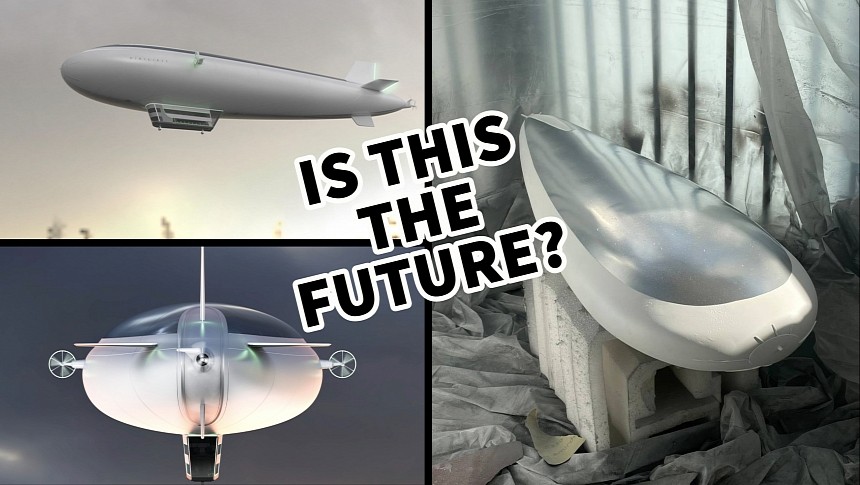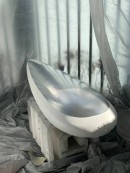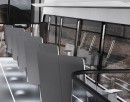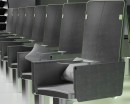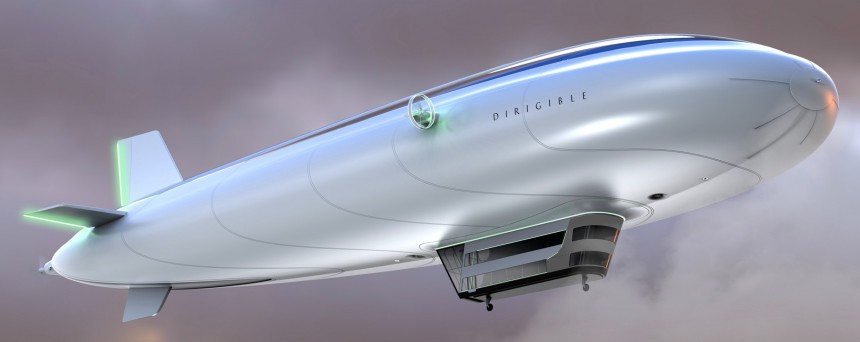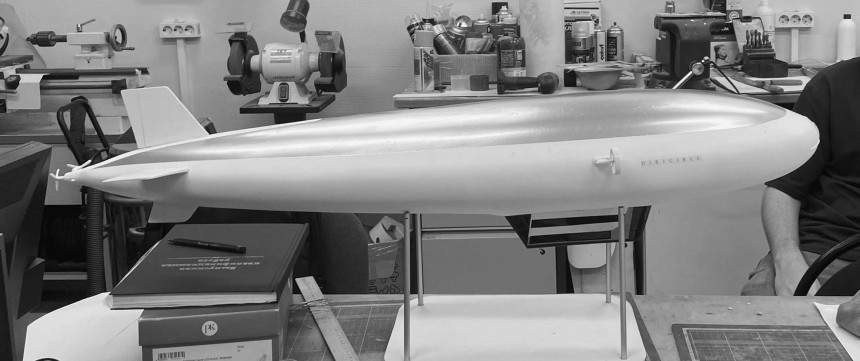If you ever mention the word dirigible or airship to anyone, you'll typically get two answers, Hindenburg and marketing. The first was an unfortunate event that led to the demise of an industry, and the second seems to be the only alternative use for these floating giants.
We've all seen blimps and other gas-filled giants floating across our skies during events such as baseball or football games, but these machines are but a shadow of what the dirigible was intended to be, a transportation system meant to carry human loads in style, grace, and sheer luxury. That's where the Hindenburg comes in, literally scaring people away from this industry.
However, as time has gone by, technology has advanced, and this means new and better solutions to existing problems. This has led Juliana Juleva, an industrial designer from Moscow, to take a crack at reinventing the blimp and the experience it can bring. No need to buckle up for this ride because it's a smooth one.
At the beginning of this project, Juliana underlines a few benefits of airships, how they can now be safely crafted and operated, and above all, the fact that they can be one of our airway's greenest alternatives to traveling and even carrying cargo. One massive downside, however, is the current lack of any infrastructure for these sorts of vehicles. After all, airplane design and construction was the winner of the airtime industry. I think it has a whole lot to do with the difference in the traveling speed of the two machines.
For example, we all know the feeling of taking flight at speeds upwards of 175 mph (282 kph). In comparison, Goodyear's GZ-20 blimp cruises at speeds upwards of 35 mph (56 kph) in no-wind conditions. Blimps are more like the turtle of this story, and airplanes are the hare. They'll both get you there, but blimps and other dirigibles will do it at a pace to rival a Savannah safari. You've got time to take pictures, sip a mimosa, and scope out the local wildlife.
This means a few things for blimps. Because of their lowered cruising speeds, long-range travel is something that is currently out of the question. Unless, of course, the cabin includes sleeping spaces, a restaurant, bathroom facilities, and other activities to kill time while traveling across the Atlantic. Let's do the math. The shortest distance between New York and London is 3,461 mi (5,570 km). At 35 mph, that's around 99 hours in flight. Divide that by 24 hours, and you'll be flying for four days and a tad over two hours. I'd prefer a four-hour tour over the Grand Canyon instead.
All this leads me to the next issue that dirigible design accompanies: the cargo bay or passenger compartment. Because airships like this are basically massive balloons that carry some cargo, that load can't exceed the lifting capacities of helium. To put things into perspective, you need around 1,450 cu ft (41 cu m) of helium to lift 100 lbs (45 kg).
As a result, countless dirigibles we see include a massive bulbous construction for holding helium but only a tiny, almost inexistent cabin for passengers and cargo. However, to help maximize the passenger capacity of Juliana's concept, she designed the cabin to be constructed from nothing more than lightweight metals with fiberglass skin and large polycarbonate windows.
What I liked about this enclosure was the level of visibility into and out of the space. This was done to maximize the viewing pleasure of those onboard. After all, if we explore this concept in its entirety, we can clearly pick up on the fact that this bugger isn't going to be carrying much cargo but, rather, is aimed at pure leisure and entertainment purposes.
For example, two floors are witnessed in the design. The first floor includes spaces like the kitchen, cockpit, toilet, and observation deck. The sides of the cabin are lined with floor-to-ceiling windows, and seating for guests ensures you never miss a moment of any terrestrial action you spot. Luggage racks overhead also hint at just how far you'll be traveling, and so does the lack of any bedding spaces.
The second floor follows a similar layout to the first. Still, it eliminates the bathroom and kitchen and replaces them with seating suitable for two people instead of just one. An "overview" space is also created by removing the cockpit. The same floor-to-ceiling windows complete this space too.
Now, most designers would consider this project as being finished, not Juliana. To show the world that she means business, this bright mind took things further by focusing on interior design and the functionality behind spaces like the bathroom and kitchen. Everything from the service trolley used to bring food and drink to passengers to the elevator and how cooking facilities are arranged, all have seen Juliana's touch. Oh, and there's even a physical scale model to accompany the renderings in the gallery.
Sure, it will be some time before we see dirigibles and blimps available for tours and or short-range travels, but there's something you need to be aware of. Recent years have seen a resurgence in airship design. A few concepts were even unveiled by some of the world's most renowned superyacht designers. What does all this mean? We might be able to take a ride on this wild side pretty soon. I just hope fees will be within the financial means of the average Joe.
However, as time has gone by, technology has advanced, and this means new and better solutions to existing problems. This has led Juliana Juleva, an industrial designer from Moscow, to take a crack at reinventing the blimp and the experience it can bring. No need to buckle up for this ride because it's a smooth one.
At the beginning of this project, Juliana underlines a few benefits of airships, how they can now be safely crafted and operated, and above all, the fact that they can be one of our airway's greenest alternatives to traveling and even carrying cargo. One massive downside, however, is the current lack of any infrastructure for these sorts of vehicles. After all, airplane design and construction was the winner of the airtime industry. I think it has a whole lot to do with the difference in the traveling speed of the two machines.
For example, we all know the feeling of taking flight at speeds upwards of 175 mph (282 kph). In comparison, Goodyear's GZ-20 blimp cruises at speeds upwards of 35 mph (56 kph) in no-wind conditions. Blimps are more like the turtle of this story, and airplanes are the hare. They'll both get you there, but blimps and other dirigibles will do it at a pace to rival a Savannah safari. You've got time to take pictures, sip a mimosa, and scope out the local wildlife.
All this leads me to the next issue that dirigible design accompanies: the cargo bay or passenger compartment. Because airships like this are basically massive balloons that carry some cargo, that load can't exceed the lifting capacities of helium. To put things into perspective, you need around 1,450 cu ft (41 cu m) of helium to lift 100 lbs (45 kg).
As a result, countless dirigibles we see include a massive bulbous construction for holding helium but only a tiny, almost inexistent cabin for passengers and cargo. However, to help maximize the passenger capacity of Juliana's concept, she designed the cabin to be constructed from nothing more than lightweight metals with fiberglass skin and large polycarbonate windows.
What I liked about this enclosure was the level of visibility into and out of the space. This was done to maximize the viewing pleasure of those onboard. After all, if we explore this concept in its entirety, we can clearly pick up on the fact that this bugger isn't going to be carrying much cargo but, rather, is aimed at pure leisure and entertainment purposes.
The second floor follows a similar layout to the first. Still, it eliminates the bathroom and kitchen and replaces them with seating suitable for two people instead of just one. An "overview" space is also created by removing the cockpit. The same floor-to-ceiling windows complete this space too.
Now, most designers would consider this project as being finished, not Juliana. To show the world that she means business, this bright mind took things further by focusing on interior design and the functionality behind spaces like the bathroom and kitchen. Everything from the service trolley used to bring food and drink to passengers to the elevator and how cooking facilities are arranged, all have seen Juliana's touch. Oh, and there's even a physical scale model to accompany the renderings in the gallery.
Sure, it will be some time before we see dirigibles and blimps available for tours and or short-range travels, but there's something you need to be aware of. Recent years have seen a resurgence in airship design. A few concepts were even unveiled by some of the world's most renowned superyacht designers. What does all this mean? We might be able to take a ride on this wild side pretty soon. I just hope fees will be within the financial means of the average Joe.
